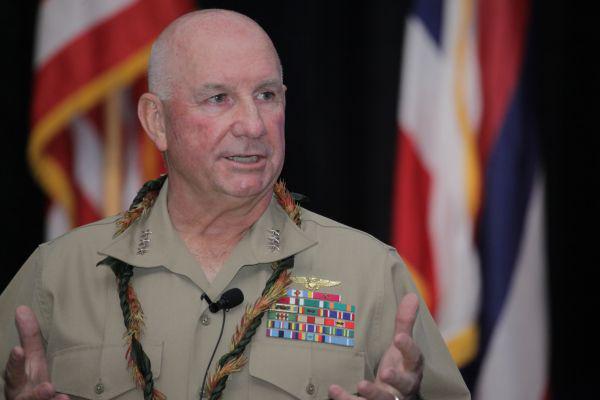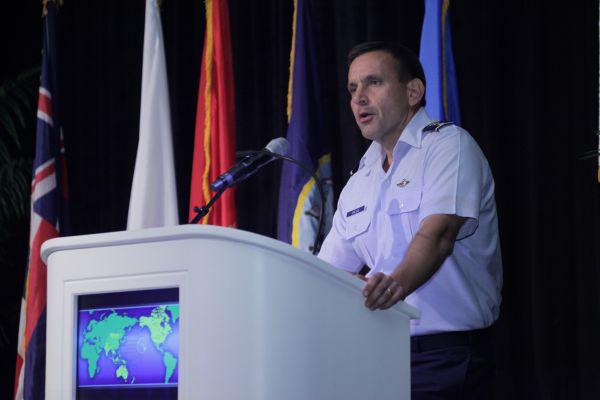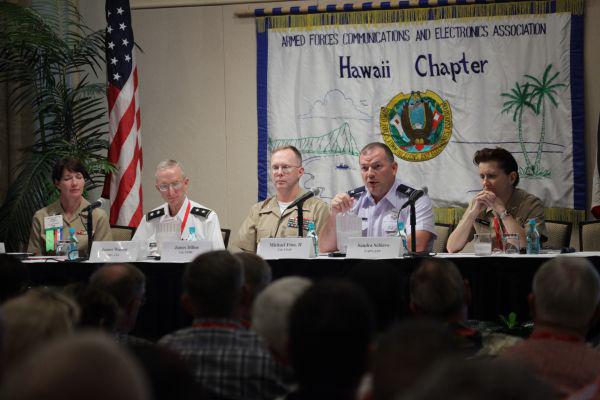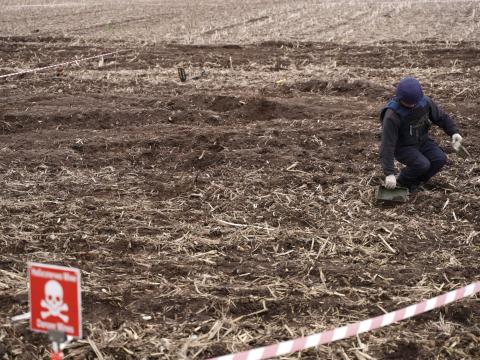Asia-Pacific Challenges Reshape U.S. Military Needs
TechNet Asia-Pacific 2013 Online Show Daily, Day 1
Quote of the Day:
"If you allow the United States to operate out of sanctuary, we will beat the crap out of you." - Lt. Gen. Stanley T. Kresge, USAF, vice commander, U.S. Pacific Air Forces, addressing potential adversaries.
The recent U.S. strategic pivot toward the Pacific has placed that region at the forefront of change in the military. Where in the recent past activities in the area of responsibility (AOR) for the U.S. Central Command (CENTCOM) defined military needs, now the requirements for the U.S. Pacific Command (PACOM) are emerging as the leading edge of the defense technology sword.
That trend was clearly visible in discussions by speakers and panelists on the first day of TechNet Asia-Pacific 2013 in Honolulu, Hawaii. Being held December 3-5 at the Hilton Hawaiian Village, the event features a number of international government, industry and military experts focusing on the conference theme of Building Coalitions Through Cyber.
Unlike many conferences that extol the virtues of cyber to the exclusion of opposing views, this event included discussions of its hazards. Lt. Gen. Thomas L. Conant, USMC, deputy commander of the U.S. Pacific Command, quoted his commander, Adm. Samuel J. Locklear III, USN, as saying, “We have built cyber on a house of cards.”
The general stated that PACOM is beholden to what cyber has promised, which may be more than it can deliver. And, U.S. forces must expect to operate without at least some of their cyber assets in a time of conflict.
“We’re going to be on a denied battlespace, they won’t let us have all the comms,” Gen. Conant said of cyberactivities by adversaries. “We’ll have to learn how to do task forces again.”
One of the big vulnerabilities threatening cyber is one of the most important aspects of Asia-Pacific operations—coalitions. Several speakers, including Gen. Conant, emphasized coalition building as a requisite for successful operations ranging from humanitarian assistance/disaster relief (HA/DR) to warfighting. However, coalition partners could be an Achilles Heel for cyber security.
Col. Michael Finn II, USAF, director of communications and chief information officer, headquarters, U.S. Pacific Air Forces, noted not everyone can keep up with network security. “We should be concerned about our partner countries,” he declared. “Many of our partner countries are not ready. Many are at a disadvantage” in terms of cyber security.
Maj. Gen. James T. Walton, USA, commanding general of the 311th Signal Command (Theater) and U.S. Army Pacific G-6, also warned, “We have a wide spectrum of cyber maturity across the AOR.” And, Col. James Dillon, USMC, assistant chief of staff for G-6, Marine Forces Pacific, declared, “We live in a pretty rough neighborhood out here from a cyber perspective.”
Capt. Sandra Schiavo, USN, deputy director, N-6, U.S. Pacific Fleet, cited the need for network situational awareness—“our own cyber cop. It seems we’ve been working on that for a long time,” she observed.
The U.S. Pacific Air Forces has one solution to cyber challenges. The organization will combine its A-3 with its A-6. Consolidating operations with cyber will give Pacific Air Forces “a lot of synergy combining the -3 with the -6,” offered Col. Finn.
The concept of cyber readiness has a different perspective from the operations side and the cyber side. This consolidation helps provide warfighting integration across the entire network, the colonel said.
“We need to apply some cyber common sense to all of our cyber elements—not just the NIPRNET [nonsecure Internet protocol router network] and SIPRNET [secret Internet protocol router network],” he stated.
Combining the two elements will not eliminate specialties. “You’ll see a flying deputy and a cyber deputy” the colonel offered.
In terms of command and control (C2), the force should be weighing its C2 capabilities before it embarks on a military plan, according to the vice commander of the U.S. Pacific Air Forces. Lt. Gen. Stanley T. Kresge, USAF, decried what he described as “oldthink in the U.S. military—which is how we do things today.” This oldthink follows the template of building a military plan and then “sprinkling” C2 on it, he charged; adding, “Instead, you have to understand your limitations in C2 in step one—not what we do today.”
In addition to reducing or at least not increasing military dependence on cyber, the United States should rethink deterrence, Gen. Kresge offered. He noted the definition of deterrence is to never allow a potential adversary to believe that they have a military option that will succeed.
This is especially vital as enemies know that they cannot afford to let the United States operate out of sanctuary. So, they are working hard on sanctuary denial through a variety of kinetic and digital approaches.
Adversaries know, “If you allow the United States to operate out of sanctuary, we will beat the crap out of you,” the general stated.
As PACOM addresses a growing list of missions, its requirements are evolving as well. Foremost among these is a solution to the need for effective networking in a region where infrastructure is insufficient or nonexistent. Col. Dillon noted that most U.S. armed forces have become comfortable falling into forward operating bases with big pipes. While Marines often enter a theater and set up their links, the Philippines typhoon relief effort known as Operation Damayan illustrated that the Marines could have used a lightweight communications system that does not require a lot of lift or power.
We want a system that provides the same level of communications, data storage and information exchange in a bandwidth challenged environment,” the colonel declared.
He also called for embedding ways of conserving bandwidth so that forces need not use appliqués for that task. Transmission systems should have built-in bandwidth compression, he offered.
Coming up on the second day of TechNet Asia-Pacific 2013: A breakfast address by Maj. Gen. Mike J. Milford, Australia Military; and panel discussions focusing on intelligence and cyber, coalition operations and cyber age leadership. Complete coverage is at Event eNews: TechNet Asia-Pacific 2013.







Comments